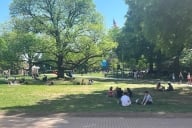You have /5 articles left.
Sign up for a free account or log in.
Do you know who your future students are, and is your institution ready for them?
Nathan Grawe’s The Agile College has prompted this question and many more. I started reading the book last week and I have been struck by the alignment between the challenges Grawe identifies and the work of the American Council on Education’s Learner Success Lab (LSL). I am an advisor for the lab and have appreciated the integrated student success frameworks provided by the LSL model - link here. I have been fortunate to serve as an advisor to two institutions: Western Oregon University (WOU) in cohort 1 and New Jersey CIty University (NJCU) in cohort 2. I am hoping to visit both universities in February, but COVID-19 does seem to be ruling our travel plans these days so, I am adopting a flexible approach and planning for both in-person and virtual visits
I was able to hear Grawe’s keynote at the New England Commission of Higher Education’s 2021 meeting this past December and immediately added his book, The Agile College, to my 2022 higher ed to-read list.. I’ll have more to say about the book once I finish it, but for now, I want to share some initial thoughts about the synergy between Grawe’s thinking on Strategies and Tactics for Tackling Disruptive Change (Chapter 5) and the work of ACE’s Learner Success Lab.
One main focus of this chapter is on using tactics vs. strategies to meet institutional enrollment goals. Tactics are short term, somewhat desperate moves. Strategies change the culture of your institution.
The focus on an “integrated approach” - a strategy to recruiting, retaining, persisting, and graduating new student groups requires that institutions take a more holistic approach. The Learner Success Lab takes this approach by centering the learner and her success in the work that our institutions do. One of my a-ha moments in the lab has been that while our students do not care about our org charts, the ways in which we organize our institutions has profound and lasting impacts on the success or lack thereof of our students.
Unfortunately, most of our institutions are not organized to optimize the success of our current students let alone our future students. Instead, we are organized by business functions and we inherit org charts that we modify over time but we do not radically alter because - the trains need to keep running and how do you build a new train (or boat/airplane) at the same time?
This prompts a series of questions: What do you do while you work towards a new structure? Do you create a working group, task force, or committee focused on learner success? Do institutional leaders give these groups permission to make recommendations to reorganize their institutions to facilitate success? How can leaders encourage and empower faculty and staff to think bigger, bolder, and outside the box? Perhaps they can begin by saying that nothing is off the table and no idea is too radical.
In a student’s life, everything we do intersects. However, almost every barrier they encounter is one that we have created. Our systems don’t talk to one another. Our units don’t interact or they report to different Vice Presidents with different missions. The mission of our institutions is focused on the success of our students. Each leader should be asking herself how does my unit contribute to the success of our students?
One of the initial points of alignment for learner success is definitional. Institutions ask themselves - How does the institution define learner success? What are the hallmarks of a successful learner? What does a successful learner look like? What are the barriers to success for our learners? How can we remove them?
Often it is a policy or set of policies that need to be changed or implemented more systematically. Or it might be a process that is broken or outdated and needs to be fixed.
Increasingly, the biggest barriers to the success of our students are life situations that pre-exist their time at our institutions. As we recruit new student groups, we are likely to see more students facing these challenges. Some of the most urgent issues our students are facing include food insecurity and childcare. Our students can’t be successful if they do not have enough to eat and they can’t come to campus if they don’t have childcare.
Does your institution have a food pantry? Do you help your qualifying students get their SNAP benefits? Do you offer assistance for students dealing with housing instability? What do you do when you find students sleeping in the library? Do you have a plan in place? Do you provide flexible online and virtual options for students who can’t make it to campus for in-person events? Do you know who your students are? Do you know what they need to be successful? Are you able to strategically re-orient your institutions to create the conditions for their success?
And, to Grawe’s point, do you know who your future students are and are you ready for them? What do you need to do to get ready for the success of your future students?
Mary Churchill is the former chief of policy and planning for Mayor Kim Janey in the city of Boston and current associate dean for strategic initiatives and community engagement at Wheelock College of Education and Human Development at Boston University. She is co-author of When Colleges Close: Leading in a Time of Crisis and an ICF certified leadership coach.




